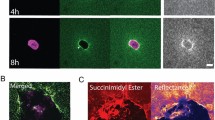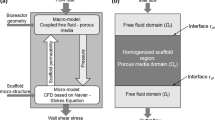Abstract
Cells, the living components of tissues, bathe in fluid. The pericellular fluid environment is a challenge to study due to the remoteness and complexity of its nanoscale fluid pathways. The degree to which the pericellular fluid environment modulates the transport of mechanical and molecular signals between cells and across tissues is unknown. As a consequence, experimental and computational studies have been limited and/or highly idealized. In this study we apply a fundamental fluid dynamics technique to measure pericellular permeability through scaled-up physical models obtained from high resolution microscopy. We assess permeability of physiologic tissue by tying together data from parallel experimental and computational models that account for specific structures of the flow cavities and cellular structures therein (cell body, cell process, pericellular matrix). A healthy cellular network devoid of cellular structure is shown to exhibit permeability on the order of 2.8 × 10−16 m2; inclusion of cellular structures reduces permeability to the order of 10−17 to 10−18 m2. These permeability studies provide not only unprecedented quantitative experimental measures of the pericellular fluid environment but also provide a novel measure of “infrastructural integrity” that likely influences the efficiency of the cellular communication network across the tissue.








Similar content being viewed by others
Abbreviations
- μ :
-
viscosity of fluid
- ρ :
-
density of fluid
- k :
-
intrinsic permeability of specimen
- κ :
-
hydraulic conductivity
- Q :
-
volume flow rate
- L :
-
length of specimen
- t :
-
permeation/diffusion time
- g :
-
gravitational constant
- h :
-
height above specimen surface
- V :
-
velocity
- P :
-
inlet pressure
- p :
-
fluid pressure
- ε:
-
characteristic pore/channel dimension
- Re :
-
Reynolds number
- \( \dot{m} \) :
-
mass flow rate
- A :
-
cross-sectional area of specimen
- u :
-
axial pipe velocity
- R :
-
radius of pericellular channel
- z :
-
axial pipe coordinate
- r :
-
radial pipe coordinate
- C :
-
concentration
- D :
-
diffusion coefficient
References
Ackroyd JAD (2002) Sir George Cayley, the father of aeronautics. Part 1. The invention of the airplane. Notes Rec R Soc Lond 56:167–181
Alexopoulos LG, Setton LA, Guilak F (2005) The biomechanical role of the chondrocyte pericellular matrix in articular cartilage. Acta Biomater 1:317–325
Anderson EJ, Kaliyamoorthy S, Alexander JID, Knothe Tate ML (2005) Nano-micro scale models of periosteocytic flow show differences in stresses imparted to cell body and processes. Ann Biom Eng 33:52–62
Anderson EJ, Falls TD, Sorkin AM, Knothe Tate ML (2006) The imperative for controlled mechanical stresses in unraveling cellular mechanisms of mechanotransduction. Biomed Eng Online 5:27
Astarita G (1997) Dimensional analysis, scaling, and orders of magnitude. Chem Eng Sci 52:4681–98
Baals DD, Corliss WR (1981) Wind tunnels of NASA. Scientific and technical branch, National Aeronautics and Space Administration, SP-440, Washington, D.C
Bardet JP (1997) Experimental Soil Mechanics. Prentice-Hall, New Jersey
Biot MA (1941) General theory of three-dimensional consolidation. J Appl Phys 12:155–64
Bridgman P (1922) Dimensional analysis. Yale University Press, New Haven
Chang J, Poole CA (1996) Sequestion of type VI collagen in the pericellular microenvironment of adult chrondrocytes [sic] cultured in agarose. Osteoarthritis Cartilage 4:275–285
Coleman HW, Steele WG (1999) Experimentation and uncertainty analysis for engineers. Wiley, New York
Dillaman RM, Roer RD, Gay DM (1991) Fluid movement in bone: theoretical and empirical. J Biomech 24:163–177
Einstein A (1911) Elementare Betrachtungen ueber die thermische Molekularbewegung in festen Koerpern. Ann Phys 35:679–94
Fleury ME, Boardman KC, Swartz MA (2006) Autologous morphogen gradients by subtle interstitial flow and matrix interactions. Biophys J 91:113–121
Goldstein RJ (1996) Fluid mechanics measurements. Taylor & Francis, Washington, D.C
Gupta T, Haut Donahue TL (2006) Role of cell location and morphology in the mechanical environment around meniscal cells. Acta Biomater 2:483–492
Han Y, Cowin SC, Schaffler MB, Weinbaum S (2004) Mechanotransduction and strain amplification in osteocyte cell processes. Proc Natl Acad Sci 101:16689–16694
Johnson MW, Chakkalakal DA, Harper RA, Katz JL (1980) Comparison of the electromechanical effects in wet and dry bone. J Biomech 13:437–442
Knothe Tate ML (2001) Mixing mechanisms and net solute transport in bone. Ann Biomed Eng 29:810–11
Knothe Tate ML (2002) Micropathoanatomy of osteoporosis—indications for a cellular basis of bone disease. Adv Osteoporotic Fract Mgmt 2:9–14
Knothe Tate ML (2003) “Whither flows the fluid in bone?” An osteocyte’s perspective. J Biomech 36:1409–1424
Knothe Tate ML (2007) Multiscale computational engineering of bones: state-of-the-art insights for the future. In: Bronner F, Farach-Carson MC, Mikos AG (eds) Engineering of Skeletal Tissues, vol 3 Springer, London, p 143
Knothe Tate ML, Knothe U (2000) An ex vivo model to study transport processes and fluid flow in loaded bone. J Biomech 33:247–254
Knothe Tate ML, Niederer P, Knothe U (1998) In vivo tracer transport through the lacunocanalicular system of rat bone in an environment devoid of mechanical loading. Bone 22:107–117
Korhonen RK, Julkunen P, Rieppo J, Lappalainen R, Konttinen YT, Jurvelin JS (2006) Collagen network of articular cartilage modulates fluid flow and mechanical stresses in chondrocyte, Biomech Model Mechanobiol 5:150–159
Liebschner M, Keller T (1998) Hydraulic strengthening affects the stiffness and strength of cortical bone. Comput Meth Bioeng 20:761–762
Maroudas A (1976) Transport of solutes through cartilage: permeability to large molecules. J Anat 122:335–347
Means RE, Parcher JV (1963) Physical properties of soils. Charles E. Merrill Books, Columbus
Mishra S, Knothe Tate ML (2003) Effect of lacunocanalicular architecture on hydraulic conductance in bone tissue: implications for bone health and evolution. Anat Rec A Discov Mol Cell Evol Biol 273:752–762
Nicholson C (1988–1989) Issues involved in the transmission of chemical signals through the brain extracellular space. Acta Morphol Neeri Scand 26:69–80
Patel RB, O’Leary JM, Bhatt SJ, Vasanja A, Knothe Tate ML (2005). Determining the permeability of cortical bone at multiple length scales using fluorescence recovery after photobleaching techniques. Proceedings of the Orthopaedic Research Society
Rayleigh L (1892) On the question of the stability of the flow of fluids. Philos Mag 34:59–70
Rayleigh L (1904) Fluid friction on even surfaces. Philos Mag 8:66–67
Rayleigh L (1915) The principle of similitude. Nature 95:66–68
Reynolds O (1883) An experimental investigation of the circumstances which determine whether the motion of water shall be direct or sinuous, and of the law of resistance in parallel channels. Philos Trans R Soc Lond 174:935–982
Reynolds O (1895) On the dynamical theory of incompressible viscous fluids and the determination of the criterion. Philos Trans R Soc Lond 186:123–164
Sorkin AM, Knothe Tate ML (2004) “Culture shock” from the bone cell’s perspective: emulating physiological conditions for mechanobiological investigations. Am J Physiol Cell Physiol 287:C1527–C1536
Steck R, Niederer P, Knothe Tate ML (2003) A finite element analysis for the prediction of load-induced fluid flow and mechanochemical transduction in bone. J Theor Biol 220:249–259
Steck R, Knothe Tate ML (2005) In silico stochastic network models that emulate the molecular sieving characteristics of bone. Ann Biomed Eng 33:87–94
da Vinci L (1508) Ms. F. In: Johnstone RE, Thring MW (eds) Pilot plants, models, and scale-up methods in chemical engineering. McGraw-Hill, New York
Wang L, Wang Y, Han Y, Henderson SC, Majeska RJ, Weinbaum S, Schaffler MB (2005) In situ measurement of solute transport in the bone lacunar-canalicular system. Proc Natl Acad Sci 102:11911–11916
Wehrli FW, Fernández-Seara MA (2005) Nuclear magnetic resonance studies of bone water. Ann Biomed Eng 33:79–86
Weinbaum S, Cowin SC, Zeng Y (1994) A model for the excitation of osteocytes by mechanical loading-induced bone fluid shear stresses. J Biomech 27:339–360
You L, Cowin SC, Schaffler MB, Weinbaum S (2001) A model for strain amplification in the actin cytoskeleton of osteocytes due to fluid drag on pericellular matrix. J Biomech 34:1375–1386
Acknowledgements
This study has been funded in part by National Institutes of Health (AR 049351-01) and The Whitaker Foundation (RG-02-0527). The authors would like to acknowledge and thank Dr. Malcolm Cooke for his support in creating the rapid prototype experimental models, and Dr. Joseph Prahl for his comments and suggestions. This investigation was conducted in a facility constructed with support from Research Facilities Improvement Program Grant Number C06 RR12463-01 from the National Center for Research Resources, National Institutes of Health.
Author information
Authors and Affiliations
Corresponding author
Additional information
Funding: National Institutes of Health, The Whitaker Foundation.
Rights and permissions
About this article
Cite this article
Anderson, E.J., Kreuzer, S.M., Small, O. et al. Pairing computational and scaled physical models to determine permeability as a measure of cellular communication in micro- and nano-scale pericellular spaces . Microfluid Nanofluid 4, 193–204 (2008). https://doi.org/10.1007/s10404-007-0156-5
Received:
Accepted:
Published:
Issue Date:
DOI: https://doi.org/10.1007/s10404-007-0156-5




